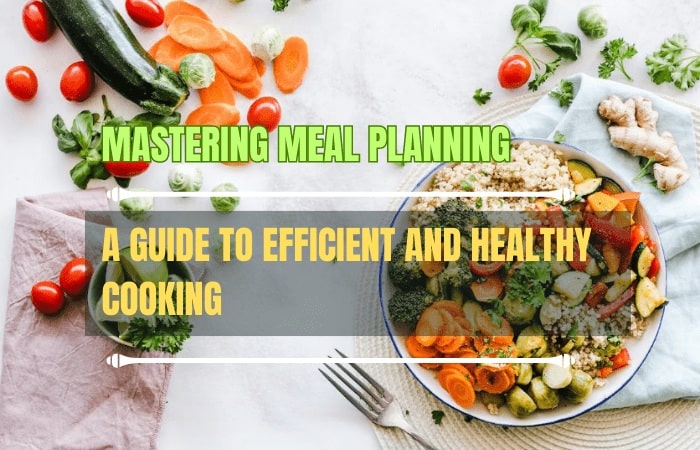Table of Contents
Introduction
In our busy lives, finding time to prepare nutritious meals can often feel like a daunting task. This is where meal planning comes to the rescue. Meal planning is a systematic approach to organizing and preparing meals in advance, offering numerous benefits such as time savings, healthier eating habits, and reduced stress.
In this article, we will explore the advantages of meal planning, provide step-by-step instructions on how to create a meal plan for the week, offer tips for balancing nutrients and incorporating variety, and share strategies for prepping ingredients in advance and organizing the kitchen for efficient cooking. By mastering meal planning, you can transform your cooking experience into an efficient and healthy journey.
Benefits of Meal Planning
1, Time Savings: One of the most significant benefits of meal planning is the time it saves. By dedicating a specific time each week to plan and prepare meals, you can streamline the cooking process. This means less time spent on figuring out what to cook each day and more time available for other activities.
2, Healthier Eating Habits: Meal planning promotes healthier eating habits by allowing you to be more intentional with your food choices. With a pre-determined meal plan, you have better control over portion sizes, ingredients, and overall nutritional balance. This can help you avoid impulsive and unhealthy food choices that often occur when you’re in a rush or feeling unprepared.
3, Reduced Stress: Meal planning reduces stress by providing structure and organization to your cooking routine. With a clear plan in place, you can avoid the last-minute panic of trying to come up with a meal idea and rushing to gather ingredients. Instead, you can approach cooking with a calm and prepared mindset.
Creating a Meal Plan for the Week
Step 1: Assess Your Needs and Preferences
- Begin by assessing your dietary needs, preferences, and any specific goals you may have, such as weight loss or incorporating more plant-based meals. Take into account your schedule, including any events or activities that may influence your meal choices.
Step 2: Plan Your Meals
- Start by selecting the number of meals you want to plan for the week, considering breakfast, lunch, dinner, and snacks. Aim for a variety of flavors, textures, and nutrients to keep your meals interesting and satisfying.
- Choose recipes that align with your dietary goals and preferences. Look for recipes that are easy to prepare and can be made in batches to save time.
- Consider incorporating seasonal produce to ensure freshness and support local farmers.
Step 3: Balance Nutrients and Incorporate Variety
- Aim for a balanced meal plan that includes a combination of lean proteins, whole grains, fruits, vegetables, and healthy fats.
- Include a variety of colors and flavors in your meals to make them visually appealing and enjoyable.
- Be mindful of portion sizes to ensure you’re meeting your nutritional needs without overeating.
Step 4: Make a Shopping List
- Once you have your meal plan, create a shopping list that includes all the ingredients you’ll need for the week.
- Organize your list by sections of the grocery store to save time during shopping.
- Check your pantry and refrigerator to see what ingredients you already have on hand and only purchase what you need.
Step 5: Prep Ingredients in Advance
- Dedicate some time to prepping ingredients in advance, such as washing and chopping vegetables, marinating proteins, or pre-cooking grains. This will significantly reduce your cooking time during the week.
- Store prepped ingredients in airtight containers or bags to maintain freshness and ease of use.
Strategies for Efficient Cooking
1, Utilize Batch Cooking
Batch cooking involves preparing larger portions of certain meals that can be enjoyed as leftovers or frozen for future use. This saves time and ensures you always have a healthy meal readily available.
2, Use the “Cook Once, Eat Twice” Approach
When preparing meals, consider how you can repurpose ingredients or leftovers into new dishes. For example, roasted chicken can be used in salads, wraps, or stir-fries the next day.
3, Organize Your Kitchen
Keep your kitchen organized and well-stocked with essential cooking tools and pantry staples. This will prevent time wasted searching for ingredients or utensils while cooking.
Utilize storage solutions such as labeled containers or shelf organizers to maintain order and easy access to ingredients.
4, Cook in Batches
Rather than cooking each meal from scratch every day, cook larger portions and divide them into individual servings. This allows you to enjoy ready-made meals on busier days or when you need a quick and convenient option.
Conclusion
Mastering meal planning is a valuable skill that can transform your cooking experience into an efficient and healthy journey. By embracing the benefits of meal planning, such as time savings, healthier eating habits, and reduced stress, you can take control of your nutrition and ensure that your meals align with your goals and preferences. By following the step-by-step instructions provided, balancing nutrients, incorporating variety, and utilizing strategies for prepping ingredients and organizing your kitchen, you’ll be well on your way to efficient and enjoyable cooking. So, start planning, prepping, and savor the rewards of efficient and healthy cooking!











